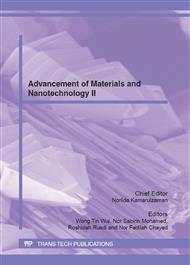[1]
M. E. Dry, Fischer–Tropsch reactions and the environment, Appl. Catal. A.189 (1999) 185-190.
Google Scholar
[2]
R. C. Brady III, R. Pettit, Reactions of diazomethane on transition-metal surfaces and their relationship to the mechanism of the Fischer-Tropsch reaction, J. Am. Chem. Soc.102 (1980) 6181–6182.
DOI: 10.1021/ja00539a053
Google Scholar
[3]
A. Tavasoli, Y. Mortazavi, A. Khodadad, K. Sadagiani, Effects of different loadings of Ru and Re on physico-chemical properties and performance of 15% Co/Al2O3 FTS catalysts, Iranian J. Chem. Chem. Eng. 35 (2005), 9-15
Google Scholar
[4]
E.Iglesia, Design, synthesis, and use of cobalt-based Fischer-Tropsch synthesis catalysts, Appl. Catal A. 161 (1997) 59-78.
DOI: 10.1016/s0926-860x(97)00186-5
Google Scholar
[5]
A.Y. Khodakov, W. Chu and P. Fongarland, Advances in the development of novel cobalt Fischer-Tropsch catalysts for synthesis of long-chain hydrocarbons and clean fuels, Chem. Rev. 5 (2007) 1692-1744.
DOI: 10.1021/cr050972v
Google Scholar
[6]
P. J. Berge, V, J, V, D. Loosdrecht, S. Barradas and A, M, V, D. Kraan, Oxidation of cobalt based Fischer–Tropsch catalysts as a deactivation mechanism, Catal. Today 58 (2000) 321–334.
DOI: 10.1016/s0920-5861(00)00265-0
Google Scholar
[7]
G. Jacobs, T. K. Das, Y. Zhang, J.Li, G. Racoillet and B. H. Davis, Fischer–Tropsch synthesis: support, loading, and promoter effects on the reducibility of cobalt catalysts, Appl. Catal. A. 233 (2002) 263–281.
DOI: 10.1016/s0926-860x(02)00195-3
Google Scholar
[8]
G. Jacobs, J. A. Chaney, P. M. Patterson, T. K. Das, and B. H. Davis, Fischer-Tropsch synthesis: Study of the promotion of Re on the reduction property of Co/Al2O3 catalysts by in situ EXAFS/XANES of Co K and Re LIII edges and XPS, Appl. Catal. A.264 (2004) 203-212.
DOI: 10.1016/j.apcata.2003.12.049
Google Scholar
[9]
A.J. Kock, H.M. Fortuin, J.W. Geus, The reduction behavior of supported iron catalysts in hydrogen or carbon monoxide atmospheres, J. Catal. 96 (1985) 261–275.
DOI: 10.1016/0021-9517(85)90379-3
Google Scholar
[10]
N. Lohitharn, J.G. Goodwin, E. Lotero, Fe-based Fischer-Tropsch synthesis catalysts containing carbide-forming transition metal promoters, J. Catal. 255 (2008) 104–113.
DOI: 10.1016/j.jcat.2008.01.026
Google Scholar
[11]
D.J. Duvenhage, N.J. Coville, Fe:Co/TiO2 bimetallic catalysts for the Fischer- Tropsch reaction I. Characterization and reactor studies: Appl. Catal. A.153 (1997) 43–67.
DOI: 10.1016/s0926-860x(96)00326-2
Google Scholar
[12]
R. M. M.Abbaslou, A. Tavasoli, A. K. Dalai, Effect of pre-treatment on physico-chemical properties and stability of carbon nanotubes supported iron Fischer–Tropsch catalysts, Appl. Catal. A. 355 (2009) 33–41.
DOI: 10.1016/j.apcata.2008.11.023
Google Scholar
[13]
V.A. de la Peña O'Shea, N.N. Menéndez, J.D. Tornero, J.L.G. Fierro, Unusually high selectivity to C2+ alcohols on bimetallic CoFe catalysts during CO hydrogenation, Catal. Lett. 88 (2003) 123–128.
Google Scholar
[14]
V.A. de la Peña O'Shea, M.C. Álvarez-Galvána, J.M. Campos-Martín, J.L.G. Fierro, Fischer–Tropsch synthesis on mono-and bimetallic Co and Fe catalysts in fixed bed and slurry reactors: Appl. Catal. A. 326 (2007) 65–73.
DOI: 10.1016/j.apcata.2007.03.037
Google Scholar
[15]
F. Tihay, G. Pourroy, M. Richard-Plouet, A.C. Roger, A. Kiennemann, Effect of Fischer–Tropsch synthesis on the microstructure of Fe–Co-based metal/spinel composite materials, Appl. Catal. A. 206 (2001) 29–42.
DOI: 10.1016/s0926-860x(00)00595-0
Google Scholar
[16]
P.T. Tanev, T.J. Pinnavaia, Mesoporous silica molecular sieves prepared by ionic and neutral surfactant templating: a comparison of physical properties, Chem. Mat. 8 (1996) 2068–2079.
DOI: 10.1021/cm950549a
Google Scholar


